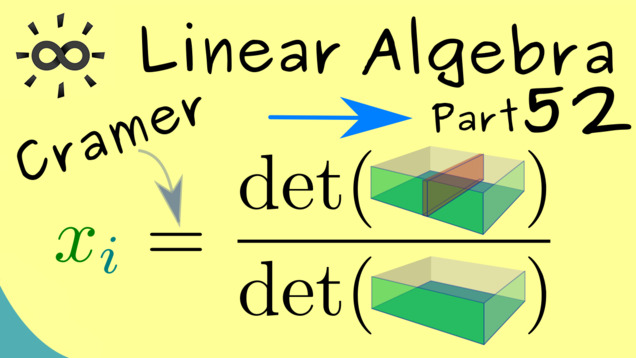
-
Title: Cramer’s Rule
-
Series: Linear Algebra
-
Chapter: Determinants
-
YouTube-Title: Linear Algebra 52 | Cramer’s Rule
-
Bright video: https://youtu.be/clVE4SXy3EA
-
Dark video: https://youtu.be/BXcueJ7EyM4
-
Quiz: Test your knowledge
-
Dark-PDF: Download PDF version of the dark video
-
Print-PDF: Download printable PDF version
-
Thumbnail (bright): Download PNG
-
Thumbnail (dark): Download PNG
-
Subtitle on GitHub: la52_sub_eng.srt missing
-
Timestamps
00:00 Intro
01:05 Determinant in two Dimensions
02:10 Determinant and singular matrices
02:30 Proposition for non-singular matrices
04:41 Cramer’s Rule
07:30 Proof of Cramer’s Rule
12:27 Credits
-
Subtitle in English (n/a)
-
Quiz Content
Q1: Let $A \in \mathbb{R}^{n \times n}$ be a square matrix with $\det(A) = 0$. Which claim is not correct?
A1: The columns of $A$ are linearly independent.
A2: The rows of $A$ are linearly dependent.
A3: $\mathrm{rank}(A) < n $
A4: $\mathrm{Ker}(A) \neq { 0 }$
A5: $A$ is not invertible.
A6: $A \mathbf{x} = \mathbf{b}$ has either no solution or infinitely many.
Q2: Let $A \in \mathbb{R}^{n \times n}$ be a square matrix with $\det(A) \neq 0$. Which claim is correct?
A1: $A \mathbf{x} = \mathbf{b}$ has a unique solution for every right-hand side $\mathbf{b}$.
A2: The columns of $A$ are linearly dependent.
A3: $\mathrm{rank}(A) < n $
A4: $\mathrm{Ker}(A) \neq { 0 }$
A5: $A$ is not invertible.
Q3: Let $A = \begin{pmatrix} a_{11} & a_{12} \ a_{21} & a_{22} \end{pmatrix} \in \mathbb{R}^{2 \times 2}$ be a square matrix with $\det(A) \neq 0$. What is the second component of the solution of $A \mathbf{x} = \begin{pmatrix} b_1 \ b_2 \end{pmatrix}$?
A1: $x_2 = \frac{\det \begin{pmatrix} a_{11} & b_1 \ a_{21} & b_2 \end{pmatrix}}{\det \begin{pmatrix} a_{11} & a_{12} \ a_{21} & a_{22} \end{pmatrix}}$
A2: $x_2 = \frac{\det \begin{pmatrix} b_1 & a_{21} \ a_{21} & b_2 \end{pmatrix}}{\det \begin{pmatrix} a_{11} & a_{12} \ a_{21} & a_{22} \end{pmatrix}}$
A3: $x_2 = \frac{\det \begin{pmatrix} a_{11} & a_{21} \ a_{21} & b_2 \end{pmatrix}}{\det \begin{pmatrix} a_{11} & a_{12} \ a_{21} & a_{22} \end{pmatrix}}$
A4: $x_2 = \frac{\det \begin{pmatrix} a_{11} & a_{21} \ a_{21} & b_2 \end{pmatrix}}{\det \begin{pmatrix} b_1 & b_2 \ a_{21} & a_{22} \end{pmatrix}}$
A5: $A$ is not invertible.
-
Last update: 2024-10